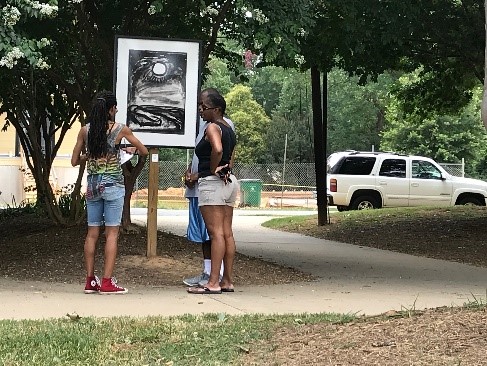This is an Eval Central archive copy, find the original at rka-learnwithus.com.
When museums started closing to prevent the spread of COVID-19 in early March, there were surges of digital initiatives across all institutions meant to reach new and existing audiences while doors were closed. It’s an amazing and overwhelming time to be involved in the digital side of museums. However, I propose that online resources are not the only way to connect with people in these times. While looking back through RK&A’s research over the years, I came across a couple of projects in which we evaluated museums “on the go” or programs that brought the museum outside its walls to a variety of venues.

One such example is Inside|Out, a program that began at the Detroit Institute of Arts (DIA) and has been replicated at other museums with funding from the Knight Foundation. The Inside|Out program brings reproductions of works from the museum’s collection to outdoor venues like parks and storefronts in communities surrounding the museum. In two studies, one for the DIA and one for the Knight Foundation, RK&A looked at the impact of the program on communities. In interviews, community partners and business owners in the neighborhoods that hosted art installations indicated the program fostered pride in the community, stimulated conversation about art among community members, cultivated the community’s interest in the arts, and positively enhanced the identity of the community. Community members who were interviewed onsite at an existing outdoor installation indicated they had positive attitudes towards the Inside|Out program and the museum, and some expressed delight at the sight of art in an unusual location.
Similarly, the Baltimore Museum of Art (BMA) had a program called BMA Outpost (the Outpost), which was a mobile art museum that was set up at a variety of temporary sites. The Outpost aimed to serve as a forum for conversations about place, home, and why the city of Baltimore matters to its residents. Visitors to the Outpost could see replicas of works from the BMA’s collection and participate in a variety of programming opportunities (i.e. creating works of art about home). After conducting case studies for ten of the former sites, we found that the Outpost was a positive experience for participants. They found it both empowering and therapeutic. Most notably, the Outpost functioned in a healing role at many of the sites. For example, during the Outpost’s tenure at Healthcare for the Homeless, participants said the installation helped them cope with their anger stemming from their homelessness. When the Outpost installation was at YO! Baltimore, students talked about the Outpost as a means of “escape” from difficult home situations.
What we can learn from these programs in light of today’s new realities is that there is a benefit to taking the museum outside of its walls (both physical and digital). Bringing art to local communities can reinforce awareness of the institution and strengthen communities’ sense of art and self. Programs that bring art reproductions to outdoor community spaces like parks or commercial districts are especially important in these times of digital content proliferation, as not all audiences are aware of online resources or even have easy access to the internet.
Some museums and artists have already started incorporating artwork into new venues. The Crystal Bridges Museum in Arkansas is displaying artwork outside hospitals and senior living facilities to help those who may be suffering from the effects of isolation. Additionally, an outdoor exhibition in Long Island featured works by 52 artists in a drive-by exhibition where spontaneous interactions, such as artists waving to visitors and viewing the art where artists live, led to a unique experience.
Personally, I’ve been spending an increased amount of time outdoors despite allergy season. I find taking walks with my dog to be one of my main stress relievers. I typically walk along a popular trail in Alexandria. I can’t help but think that that spaces like this trail would be livened up with a little art.
You can read more about the Inside|Out program evaluation here: https://www.informalscience.org/summative-evaluation-inside-out-program
You can read more about the Outpost case studies here: https://www.informalscience.org/case-studies-bma-outpost
The post Reaching Audiences Beyond the Internet During a Pandemic appeared first on RK&A.